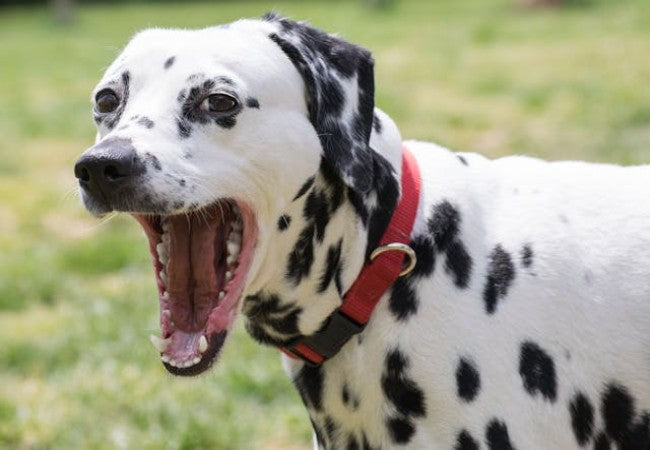Vet’s 2025 Guide to Trigeminal Neuritis in Dogs “Dropped Jaw” Explained🩺

In this article
Vet’s 2025 Guide to Trigeminal Neuritis in Dogs “Dropped Jaw” Explained🩺
By Dr. Duncan Houston BVSc
💡 Introduction
When your dog suddenly can’t close their jaw, drools, and struggles to eat, you may suspect something serious. In 2025, we recognize this as a classic case of idiopathic trigeminal neuritis—a sudden, usually immune‑mediated inflammation of the trigeminal (fifth cranial) nerve resulting in a “dropped jaw.”
Despite the frightening appearance, the prognosis is excellent, with spontaneous recovery in most dogs within weeks. Let’s explore the causes, diagnosis, compassionate care, and modern approaches to nurturing recovery. Ask A Vet supports every step. 🐶❤️
1. What Is Trigeminal Neuritis?
Trigeminal neuritis (aka trigeminal neuropathy, idiopathic trigeminal neuropathy) is inflammation—likely immune‑mediated—of the mandibular branch of the 5th cranial nerve, which controls jaw closure and carries facial sensation. When affected, dogs are unable to close their mouths: the lower jaw droops limply, though tongue movement and swallowing remain intact.
2. Causes & Who's Affected?
The condition is classified as idiopathic—the cause is unknown. Viral triggers, immune factors, or immune-mediated nerve inflammation are suspected. Evidence shows Golden Retrievers are frequently affected, but all breeds, ages, and sexes can develop it. No related factors like season or vaccination have been identified.
3. Recognizing the Signs 🕵️♂️
Signs are dramatic and unmistakable:
- Dropped jaw: inability to close the mouth, even at rest.
- Excess drooling, messy eating due to jaw weakness.
- Difficulty picking up food or toys.
- Facial numbness in ~35% of cases and Horner’s syndrome in ~8%.
- Swallowing unaffected, so dehydration is rare—but nutritional intake must be supported.
Swallowing remains intact because the tongue and esophagus remain innervated by other nerves.
4. Diagnosing Trigeminal Neuritis 🧪
Diagnosis is one of exclusion.
4.1 Clinical Evaluation
History and neurological exam reveal jaw paralysis and sometimes face sensation deficits, without evidence of jaw injuries or disease.
4.2 Blood & Supportive Tests
Bloodwork, urinalysis, imaging (X-ray, CT, MRI), and EMG or muscle biopsy may be used to rule out fractures, tumors, infections, rabies, etc.
4.3 Advanced Imaging
MRI may show nerve inflammation or middle-ear fluid—CSF analysis may show pleocytosis, helping exclude tumors or infection.
5. Treatment & Supportive Care 🏥
There is no drug to treat the inflammation directly—trigeminal neuritis is self‑limiting.
5.1 Nursing & Hydration
- Assist feeding with soft/mechanical aid (meatballs, gruel) to allow lapping.
- Offer water frequently; use syringes or a bottle if needed.
- Esophagostomy or gastrostomy tube is recommended if intake is insufficient.
- Implement gentle jaw massages to maintain muscle tone.
5.2 Medications
Steroids may be tried in stubborn cases, but don’t hasten recovery. Pain relief is rarely needed and not a key focus.
5.3 Eye Care & Hygiene
- Ensure the eyes are lubricated (e.g., in Horner’s syndrome cases).
- Keep drool from skin folds to prevent irritation or infection.
6. Recovery & Prognosis 🌱
- Recovery timeline: Jaw function returns in ~2–4 weeks (avg 22 days); full recovery may take up to 2 months.
- Outlook: Excellent—most dogs regain full nerve function without recurrence.
- Recurrence: Rare, though it can happen; long-term monitoring advised.
- Permanent damage: Very uncommon; nerve regeneration is strong in this condition.
7. Veterinary Tips & Owner Support 📋
- Monitor weight, hydration, and comfort daily—ask Ask A Vet for guidance.
- Keep a feeding log—share with your vet via the app for timely support.
- Pre-plan tube feeding if intake falters—when to escalate care.
- Ensure eye lubrication and skin hygiene around jaw fold areas.
- Schedule follow-up exams—evaluate functions and rule out other causes if recovery stalls.
8. Ask A Vet—Your Recovery Ally
- 24/7 symptom tracking—jaw movement, drooling, appetite
- Feeding reminders and recipe suggestions for soft, high‑calorie meals
- Photo/video assessments of jaw motion or drooling
- Automated alerts to seek in‑person vet care if weight drops or symptoms persist past 4 weeks
9. 2025 Veterinary Insights
- Retrospective data confirms excellent prognosis—even without steroids.
- Advanced imaging (MRI, CSF) helps exclude rare tumors or atypical causes.
- Ongoing immunologic research may, in the future, identify preventive or targeted therapies.
🔍 Summary Takeaways
- “Dropped jaw” is typically benign, self-resolving trigeminal neuritis.
- Diagnosis is via exclusion—thorough exams, imaging, and lab tests ensure no serious cause is missed.
- Main treatment is supportive—nutrition, hydration, and nursing are adroitly supplied.
- Most dogs fully recover in 1–2 months, with minimal risk of recurrence.
- Support from Ask A Vet ensures caregivers feel confident and controlled during the recovery journey.
Conclusion ❤️
While a sudden dropped jaw in your dog is distressing, idiopathic trigeminal neuritis is generally fully reversible. With patient, hands-on nursing and appropriate veterinary oversight, most dogs return to normal function within weeks. If signs persist, additional diagnostics may be needed, but the 2025 prognosis remains overwhelmingly hopeful. Let Dr Duncan Houston, BVSc and Ask A Vet guide you step-by-step through care and recovery.🐾
Dr Duncan Houston BVSc – offering veterinary neurology care with compassion and clarity
Discover more at AskAVet.com and download the Ask A Vet app for tailored monitoring, feeding coaching, and real‑time advice during your dog’s recovery.❤️






